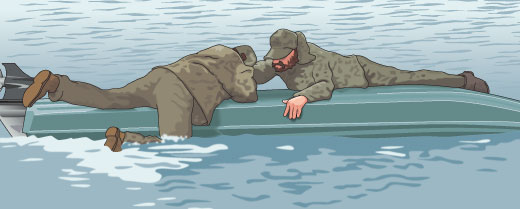What You Learned (cont.)

Elevated stands place the hunter above ground level. They can be tree stands placed in or against trees, or free-standing structures. While they offer certain advantages, they also have some drawbacks, including a degree of risk.

Portable tree stands are one category of elevated stands. These stands can be safe and environmentally friendly. Homemade stands should not be used. Commercial stands that are manufactured, certified, and tested to industry standards are best. Portable tree stands come in three basic types: hang-on stands, climbing stands, and ladder stands.

Tripods, quadpods, or tower stands are similar to a ladder tree stand but are free-standing.

When hunting from an elevated stand, you should use a fall-arrest system (FAS) that is manufactured to industry standards. Make sure your FAS includes a full-body harness, lineman’s-style belt and/or climbing belt, tree strap, tether, and suspension relief strap. Never use single-strap belts and chest harnesses. Carefully read the manufacturer’s instructions for proper use of your FAS, and follow all safety guidelines.

When you are in a tree stand, use the FAS tree strap and tether to attach your FAS full-body harness to the tree.
If you should fall while in your stand:
- Do not panic.
- Signal for help.
- Climb back onto the platform quickly.
- Act to avoid suspension trauma if you must wait for rescue. Use your suspension relief strap, or keep moving your legs.

Never carry your hunting equipment up or down the tree with you as you climb. Always use a haul line attached to your hunting equipment. Unload your firearm and open the action. Put arrows in a covered quiver secured to the bow.

Hunters often use boats in difficult conditions, such as wind, cold, and snow. Special care must be exercised to ensure a safe trip.
- Leave a hunting plan with family or friends.
- Load the boat properly.
- Make sure each person wears a life jacket.
- Do not go if wind and water conditions aren’t safe.

Before boarding the boat, unload and case each firearm. Place the firearm in the boat first. When duck hunting with two persons, sit back-to-back.

To survive a water emergency:
- Always wear a U.S. Coast Guard–approved personal flotation device (life jacket) while you’re in the boat. Life jackets will keep you afloat and help you keep warm.
- If you get caught in a storm and your boat swamps or capsizes, stay with the boat.

Sudden immersion into cold water can cause immediate, involuntary gasping; hyperventilation; panic; and vertigo—all of which can result in water inhalation and drowning. If you fall into cold water, don’t panic. Put on a life jacket immediately if you don't already have one on. Try to reboard your boat, or get as much of your body out of the water as possible.

All-Terrain Vehicles (ATVs) are special-purpose vehicles that require careful, responsible handling and good judgment. Carry firearms unloaded, cased, and on a proper gun rack. Use ATVs only to get to the hunting area or to haul an animal from the woods—don’t shoot from an ATV. Check on your state’s rules and regulations before using an ATV when hunting.